Layout and Features
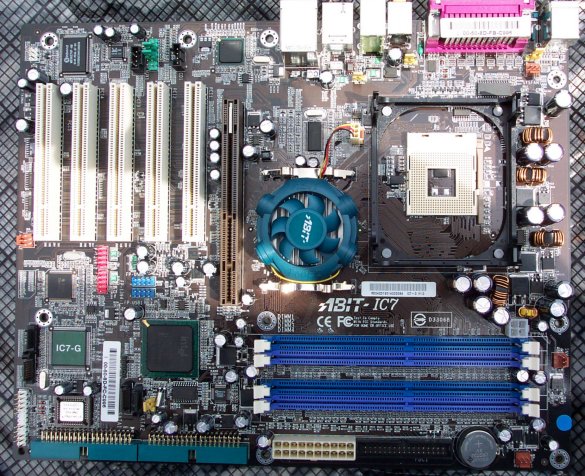
Think of the IC7-G as the IC7 with bits bolted on and you won't be too far off the mark. You'd be forgiven for thinking this was the base version with the IC7 name stuck in the middle of the board. The single sticker on the Silicon Image S-ATA controller gives the game away. So this is the all-singing, all-dancing ABIT Canterwood motherboard that should be enticing your VISA card with its range of features and performance.
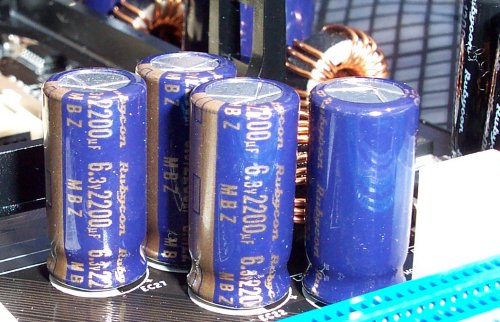
ABIT, quite proudly, build their reputation on boards that deliver clean, consistent power to the CPU. That, really, is the basis for stability. A 4-phase PWM power supply (Pulse Width Modulated) is run through a number of high-quality Rubycon capacitors. The socket area is literally littered with them. It seems as if every manufacturer is happy to rotate the ZIFF socket from its normal orientation. The board does seem pretty 'clean' in layout terms. We'll see why a little later on.
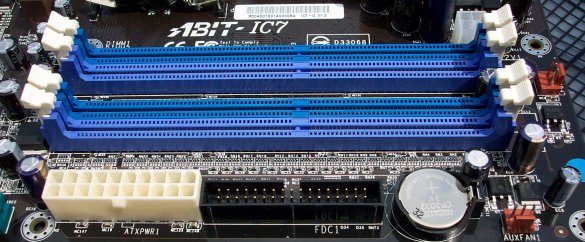
You should just be able to make out the 4-pin 12v power connector on the top-right of the above picture. Pure subjectivity here but I do like its location. All too often it's located near the AGP slot. The 4 DDR slots are colour coded to represent dual-channel operation, although the colouring isn't as distinctive as some. A total of three fan headers sit on the right-hand side of the board; that's plenty for cooling freaks. The clean layout extends to the floppy and 20-pin power ports, as one has enough room to install system RAM without difficulty.

ABIT's fancy-pants i875P MCH's cooler sure looks the part, although is it really necessary ?. The N.B's cooler's speed is somewhat adjustable from within BIOS. That still doesn't take away the shrill noise emitted by the contraption. Manufacturers such as ASUS and EPoX have both made do with extensive passive cooling, so we'd wish that ABIT would follow suit. Small diameter fans need high RPM to achieve any kind of air flow, therefore the nominal 7,000 RPM fan strapped on top of the Northbridge is viewed as an unnecessary 'extra'. Note the ICS 952607EF clock generator on the right. That's a departure from ABIT's usual Realtek approach. The ICS clock generator supports these new 200FSB CPUs. On a separate note, we're not exactly sure why ABIT leave out the AGP card locking mechanism on this board.

The bottom-left side is home to the ubiquitous ICH5/R Southbridge, which is still connected to its northern counterpart via a bi-directional HubLink. The ICH5 status ensures that this input/output hub juggles both S-ATA and P-ATA (Serial and Parallel Advanced Technology Advancement) functions. What this means to you and me is the ability to run both standard 80-pin IDE and the all-new Serial hard drives. The /R naming enables this hub of tricks to run native, on-hub S-ATA RAID0, as well as standard, independent channels. That's in addition to 8 possible USB2.0 ports, 6 PCI slots and a myriad of other useful features.
You can see the two S-ATA ports to the right of the ICH5/R. The real funs starts when you attempt to configure just how S-ATA and P-ATA will relate to one another. Suffice to say that a clear head is needed if you're attempting to use the four available channels, split between the two formats. A couple of blue USB2.0 headers provide the possibility of an extra 4 ports.
Have a look at the very top picture to see if there's anything odd about the layout.

Those with a keen eye for detail will notice that there's no 'standard' IDE ports on the motherboard. The two IDE ports are found rotated near the ICH5. Again, subjectively, we favour this layout as it gives ABIT a little more freedom near the usual DDR slot location. The primary port is on the left. Tower users may need longer cables to attach optical drivers to the secondary port on the right.
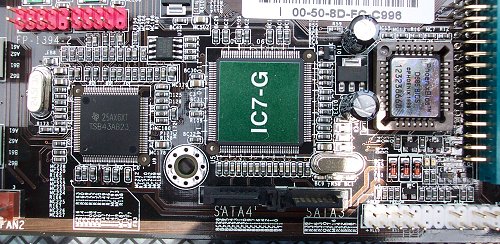
Looking at the extreme bottom-left of the motherboard highlights its deluxe nature. We already have plentiful storage potential from the ICH5/R. That, though, isn't enough to be considered deluxe, ABIT feel. The sticker hides the Silicon Image Sil3112 PCI-based S-ATA 2-port controller. This should be familiar to those who read our reviews regularly. It debuted some time ago when on-hub S-ATA controllers weren't available. Much like the ICH5/R, it supports 2 S-ATA drives in either independent or RAID0 and RAID1 formats. The benefits and disadvantage when compared to the ICH5/R are kind of obvious. RAID1 is a nice bonus, but hogging the PCI bus isn't as elegant as the on-hub architecture.
We'd previously made mention of certain transfer errors when running on an nForce2-based board. We encountered no problems when transferring and launching data to a native 120GB Seagate S-ATA drive. 2 red FireWire (1394a) headers can be seen on the top-left of the above picture. Just below, a Texas Instruments TSB43AB23 FireWire controller provides the necessary brains to run the headers, as Intel still refrain from integrating it into the I/O hub.
Realtek do make an appearance with their popular ALC650 6-channel software CODEC. ABIT try to maximise its potential by integrating digital connections on the back panel.
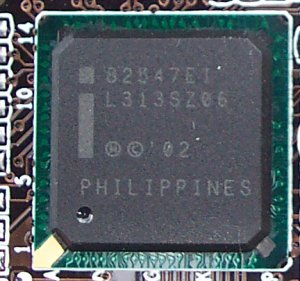
With 5 possible PCI slots to cater for, and the cumulative effects of both sets of S-ATA channels, P-ATA channels, USB2.0 and FireWire, you can imagine the probable stress on the meagre 266MB/s HubLink. That's a possible reason for ABIT to implement Intel's fifth-generation Gigabit connection. Connecting to the Northbridge via a dedicated 266MB/s link, it does take some load off the underfed HubLink. Whether you'll really see the benefit of this full duplex connection is dependant on just how well you can saturate the speed on offer. We applaud ABIT for sticking with Intel's networking vision.

A bit of everything here. Full 6-channel sound ability, optical (digital) in and out connections, 4 USB2.0 ports, a single 6-pin FireWire port, and the PS/2 ports round off an impressive back panel. This board is also compatible with ABIT's MediaXP module, further adding to its connectivity appeal.









